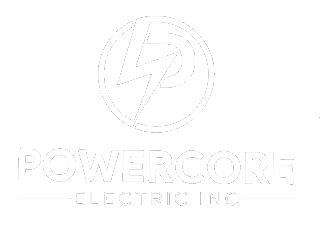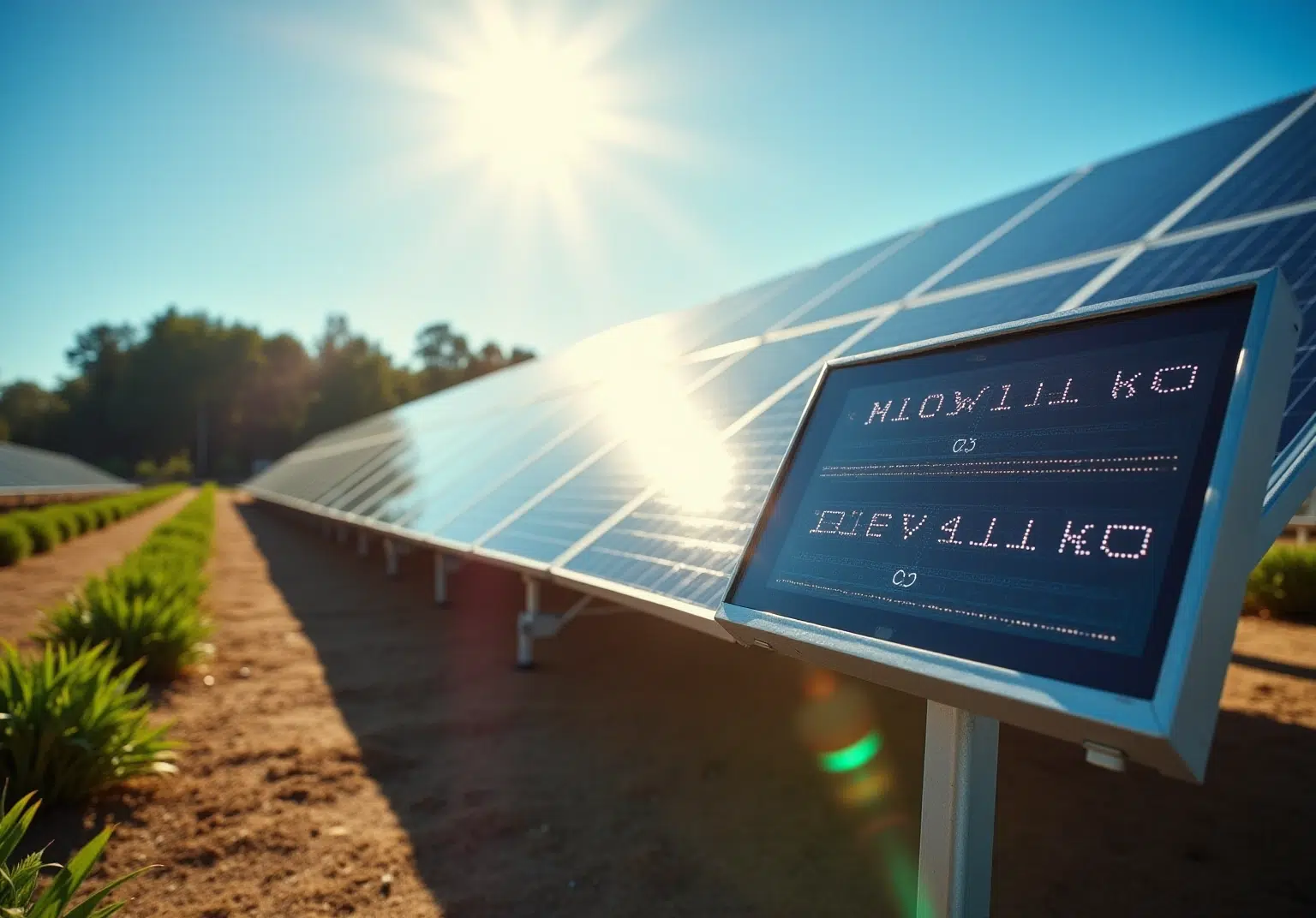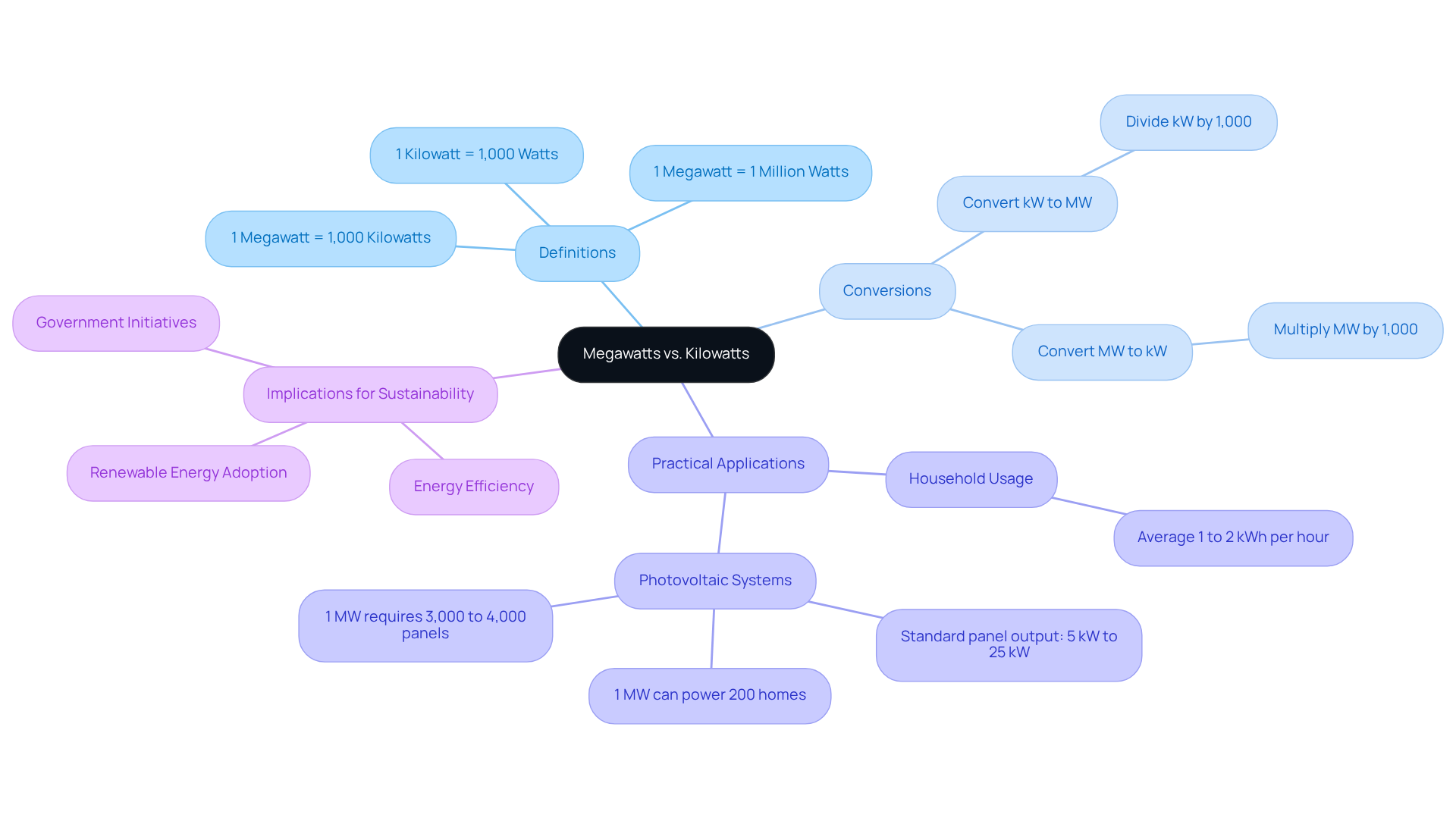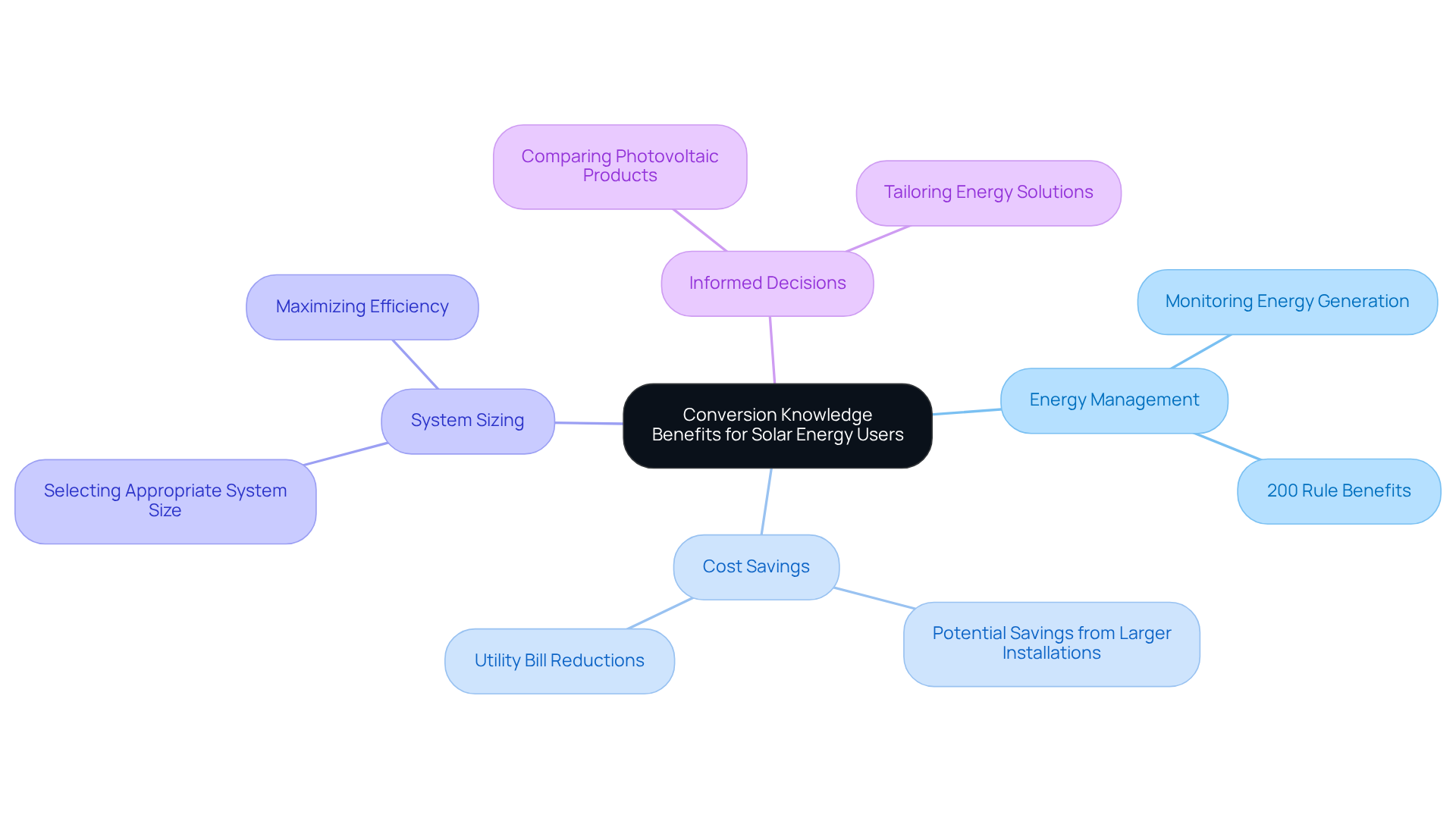Overview
Understanding that 1 megawatt is equal to 1,000 kilowatts is essential for homeowners concerned about their energy bills. This crucial conversion not only aids in grasping energy generation and consumption but also plays a significant role in the realm of renewable energy. By recognizing this distinction, homeowners can more effectively evaluate their energy needs, manage costs, and optimize their solar power installations. This knowledge ultimately fosters greater energy independence and sustainability, allowing families to feel empowered in their energy choices. Together, we can navigate the path toward a more sustainable future, ensuring that every decision made is a step toward a more resilient and eco-friendly home.
Introduction
Understanding the distinction between megawatts and kilowatts is crucial for anyone navigating the world of renewable energy, especially as we face rising energy costs and a growing emphasis on sustainability.
We understand that many homeowners are concerned about their power usage and are seeking ways to optimize it.
This article delves into the conversion from megawatts to kilowatts, revealing how this knowledge can empower you to make informed decisions about your energy consumption and solar investments.
It’s common to feel overwhelmed by the complexity of these measurements, but we’re here to help you navigate the practical needs of everyday energy management.
Define Megawatts and Kilowatts: Key Differences
As eco-conscious homeowners, you may often find yourselves concerned about rising energy bills and the impact of traditional energy sources on the environment. Understanding units of power measurement, including the fact that 1 megawatt is how many kilowatts, can empower you to make informed decisions about renewable power solutions. Since a megawatt equals one million watts and a kilowatt is one thousand watts, the question of 1 megawatt is how many kilowatts can be answered with 1,000 kW. This distinction is crucial for grasping power generation and usage, especially in photovoltaic applications. For instance, a standard residential photovoltaic panel system may be rated between 5 kW and 25 kW, while larger energy farms, like the Mammoth Solar project, boast capacities of up to 1.65 GW. By comprehending these distinctions, you can precisely evaluate your power requirements and the capabilities of your installations.
We understand that the connection between kilowatts and megawatts, particularly in terms of how 1 megawatt is how many kilowatts, is essential for assessing power efficiency and sustainability. Did you know that a photovoltaic power facility generating 1 MW can supply approximately 200 households? This demonstrates the significant potential of power generation. Considering that an average household uses about 1 to 2 kWh of electricity each hour, this understanding enables you to make informed choices regarding your power usage and the advantages of renewable systems, including government initiatives that promote such technologies. Furthermore, you might contemplate incorporating Tesla home chargers into your power solutions, which can enhance the utilization of solar power for electric vehicle charging.
As power specialist Ian Gagnon wisely notes, “When considering power and resources, it’s often beneficial to have a few reference cases for comparison.” Comprehending these metrics is vital for optimizing resource use and enhancing sustainability in your home. It’s also important to acknowledge that attaining 1 Megawatt generally necessitates around 3,000 to 4,000 photovoltaic panels, depending on their output. This offers a concrete reference for you regarding the scale of installations required to achieve specific power outputs. Together, we can work towards choosing the optimal batteries and inverters to enhance efficiency and storage, ensuring a brighter, more sustainable future for your home.
Convert Megawatts to Kilowatts: Step-by-Step Guide
We understand that navigating energy measurements can feel overwhelming at times. To help you convert megawatts to kilowatts, here are some simple steps that make this process easier for you:
-
Identify the megawatt value you wish to convert. For instance, let’s say you have 2 MW.
-
Use the conversion factor that we can rely on to determine how much 1 megawatt is how many kilowatts, which equals 1,000 kW.
-
Multiply the megawatt value by 1,000:
2 MW × 1,000 = 2,000 kW
So, you see, 2 MW is equal to 2,000 kW. This straightforward calculation can be applied to any megawatt value, making it easier for you to understand 1 megawatt is how many kilowatts, thus clarifying the power output of larger setups. Together, we can simplify these concepts and empower you to manage your energy needs more effectively.
Apply Conversion Knowledge: Benefits for Solar Energy Users
For environmentally conscious homeowners considering renewable energy options, especially under the 200% rule, understanding that 1 megawatt is how many kilowatts is crucial for the conversion between megawatts (MW) and kilowatts (kW). This knowledge directly influences power management and potential cost savings. Here are several key benefits of grasping this conversion:
- Energy Management: We know that managing energy consumption is a priority for many homeowners. By recognizing the power output of solar systems in kilowatts versus megawatts, residents can effectively monitor their energy generation. For instance, a standard residential photovoltaic panel setup rated at 8,000 watts translates to 8 kW, allowing for precise measurement of power generation. This understanding is particularly beneficial under the 200% rule, which enables homeowners to install solar systems that can generate up to 200% of their power needs, fostering greater energy independence.
- Cost Savings: It’s common to feel concerned about electricity expenses. Understanding capacity helps homeowners estimate potential savings. Larger setups, measured in megawatts, can produce significantly more energy. For example, a 1 MW photovoltaic installation, illustrating that 1 megawatt is how many kilowatts, can supply energy to approximately 166 homes daily, leading to substantial savings. Furthermore, the question of 1 megawatt is how many kilowatts can be answered by noting that it can power between 150-300 average homes, depending on efficiency, highlighting the potential for cost reduction. Homeowners who have embraced photovoltaic systems under the 200% rule have reported considerable decreases in their utility bills, reinforcing the financial benefits of understanding these conversions.
- System Sizing: When planning a photovoltaic installation, recognizing these units aids property owners in selecting the right size to meet their energy needs. This ensures they invest in a system that maximizes efficiency and minimizes costs, especially considering the larger installations allowed by the 200% rule.
- Informed Decisions: We believe that knowledge is power. Understanding power measurements empowers homeowners to make informed choices when comparing various photovoltaic products and setups. This insight is vital for selecting the best option tailored to their energy requirements, ultimately enhancing independence and aligning with sustainable living goals.
Real-life examples illustrate the impact of understanding power conversions. For instance, a grocery store in California that installed a 1.5 MW solar and storage system achieved 90% power independence, showcasing how efficient resource management can yield significant operational benefits. Moreover, homeowners who invested in enhanced photovoltaic systems, such as a 5 kW configuration, experienced substantial reductions in their monthly utility bills, demonstrating the practical advantages of grasping power conversions for individual households.
As noted by power specialists, “Megawatts (MW) measure the rate of power transfer, equivalent to 1 million watts,” underscoring the importance of these measurements in resource management. Additionally, hybrid systems that combine photovoltaic technology with storage can reduce power costs by 40-60% for factories, illustrating the potential for significant savings and improvements in power management.
In summary, embracing knowledge about kilowatts and megawatts not only supports energy management but also nurtures sustainable living and maximizes the benefits of renewable energy. For homeowners looking to optimize their solar investments under the 200% rule, together we can explore these opportunities and make informed choices that benefit both the environment and their finances.
Conclusion
Understanding the conversion between megawatts and kilowatts is essential for anyone concerned about optimizing energy usage, especially when considering renewable energy solutions. By recognizing that 1 megawatt equals 1,000 kilowatts, homeowners can make informed decisions about their energy systems, accurately assess their power needs, and contribute to a more sustainable future.
We understand that energy bills can be a significant concern. Throughout this article, we explored key insights, including the importance of recognizing the power output of solar installations, the potential benefits of energy management, and the substantial cost savings that arise from understanding these conversions. Real-life examples illustrated the practical implications of this knowledge, showing how properly sized solar systems can lead to enhanced energy independence and reduced utility bills.
Ultimately, embracing this understanding not only empowers homeowners to manage their energy consumption more effectively but also fosters a commitment to sustainable living. By taking proactive steps to explore renewable energy options and leveraging the knowledge of kilowatt and megawatt conversions, individuals can significantly impact their financial savings and environmental footprint. Together, we can embark on the journey toward energy efficiency and sustainability. Now is the time to harness this knowledge for a brighter, greener future.





